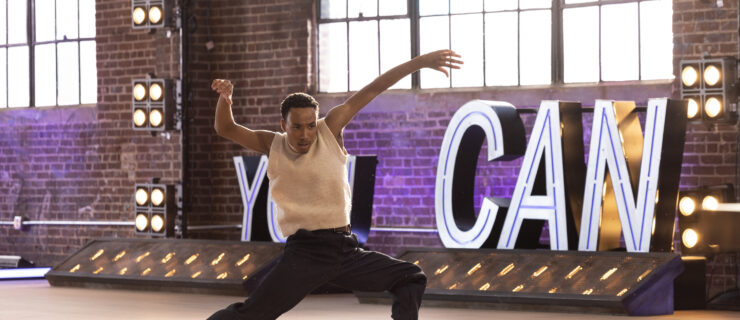(How to Get) All Eyes on You
Stage presence is the secret sauce you bring to your dancing: It makes every moment more delicious. But it’s not easy to nail down the recipe. “In auditions, I’m scanning a whole room full of dancers performing the exact same steps, and the ones who stand out have a special quality,” says Warren Carlyle, the Tony Award–winning Broadway choreographer and “So You Think You Can Dance” veteran. “There’s a luminescence to them. But it’s hard to say what it is definitively.”
Some lucky performers are just born with presence. “It can be a gift, like being a natural storyteller,” says tap virtuoso Anthony Morigerato. But while he believes stage presence is difficult to teach, he does think it can be discovered. “You can definitely improve by getting feedback in rehearsal and evaluating past performances,” he says. Here’s your guide to going beyond the steps and really moving audiences.
Perform with Your Whole Self
Stage presence is so hard to define because it’s a complex combination of many things: expression, emotion, a dialogue between you and the audience. An all-purpose smile tacked on as an afterthought is never going to cut it. “Stage presence isn’t just on your face,” says Sara Mearns, a principal dancer with New York City Ballet, who’s often praised for her passionate interpretations of iconic roles. “It’s your whole energy, from the very first step you take onstage.” To project that energy outward, she says, “you have to genuinely feel emotions, not just plaster them on. And you have to be comfortable with yourself to pull that off.”
Get Your Story Straight
If you’re having trouble connecting with the audience, start by analyzing the story or intention of the piece you’re performing. Well before you walk onstage, you’ll need to understand what the choreographer wants to say and how you can carry that message through the movement. “In rehearsals for the Broadway show After Midnight, I made the performers verbalize the story the choreography was telling,” Carlyle says. “In many cases, that made it much clearer in performance.” When Morigerato is judging at NUVO Dance Convention, he sees a lot of dancers who need to clarify this intent with their instructors. “If the performers don’t understand what the choreography is about, that negatively impacts their ability to capture my attention,” he says.
If you’re dancing a classic work, Mearns suggests researching its history, which might help you connect with the movement. “Recently, I was rehearsing George Balanchine’s Élégie,” she says. “To prepare, I read about how he created it for ballerina Suzanne Farrell, and how she performed the piece when he was dying”—a powerful backstory to draw from.
Not performing in a story ballet or a musical? You can always make up your own character arc. Kaelynn “KK” Harris, a member of the 8 Flavahz Crew, thinks about taking on a persona in every performance, “whether it’s sexy, hard, hip or girly,” she says. And she works on that character from the very first rehearsal. “In the studio, dance full-out, the same way you would perform, including facial expressions,” she says. “You want it built into your muscle memory.”
Follow the Music’s Lead
Another great way to bring more vitality to your performance is through the music. “Frequently, my interpretation of choreo-graphy is based on the meaning of the song it’s set to,” Harris says. If that song has a music video, she’ll mine it for information about tone and mood. “The goal is to make the vocal artist’s message come to life in the movement,” she says.
Try mapping out the music’s high and low points and echoing their energy in your dancing. “I think the best thing you can do is put on your headphones and listen,” Morigerato says. “Find the dynamic contrasts and try to match them. If you hear joy, put that in your expression. When the music goes full-throttle, amp up your energy.”
At competition, Morigerato adds, some dancers perform everything at full volume, regardless of the feel of the music, because they want to impress the judges. Remember that moments of quiet intensity can be just as captivating. “Performing is like telling a crazy story at lunch with your friends,” Morigerato says. “You emphasize some parts and deemphasize others, using the tone of your voice to make the story better. The dynamics of your dance need to change like that, too. Over-the-top energy the whole time is like yelling in someone’s face. If you include moments of subtlety when the music is hushed, the audience will lean in—and then, when the music intensifies, you can hit the floor, like, bang! That brings the dance to life.”
Find Your Inspiration
Morigerato urges dancers to watch a different dance video every day for inspiration. “Find clips of masters like Fred Astaire, Mikhail Baryshnikov and Gregory Hines,” he says. “If you’re a tapper, don’t just watch tap. Watch ballet or musical theater, and find something that speaks to you in each style.” The more dancers you watch or study, the more you’ll have to inspire you onstage.
Don’t be afraid to draw from your own life, too—it’s one of the best ways to tap into authentic emotion. If you’re dancing a mournful solo, think about moments when you’ve felt sad and alone. If you’re performing a joyful piece, channel the glow of your happiest memories. As you develop your craft, you’ll find that your personal experiences will shape your performances more and more. “I’m doing some of the same repertory now that I did when I was 19, but I definitely don’t perform it the same way 10 years later,” Mearns says. “Just living helps strengthen your presence onstage, and your emotional connections to movement. The experiences I’ve had in the last decade have changed everything about the way I dance, and I wouldn’t trade that for anything.”



